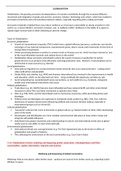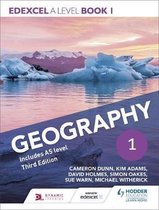GLOBALISATION
Globalisation: the growing economic interdependence of countries worldwide through the increased diffusion,
movement and integration of goods and services, economy, industry, technology and culture, which has resulted in
increased connectivity and communication between nations, especially regarding policy making and trade.
Increased complexity of global flows may reduce resilience as it increases vulnerability to shocks anywhere in the
world, e.g. a natural disaster, economic recession, war, or political conflict. Resilience is the ability of a region to
rapidly regain normal state of affairs following an adverse change.
Types of Globalisation:
Economic globalisation:
Growth of transnational companies (TNCs) which have a global influence/presence, accelerate cross-border
exchanges of raw material components, manufactured goods, shares, stocks and investments (in the form of
Foreign Direct Investment)
Online purchasing between countries is common (such as Amazon.com Inc. which has been referred as ‘one
of the most influential economic and cultural forces in the world’)
Globalisation allows economic specialisation where the country focusses on production of certain
goods/services it can produce most efficiently, lowering production costs. However, if outcompeted can be
detrimental to local economy (e.g. Detroit)
Social globalisation:
International migration has created extensive family networks that cross national borders – making world
cities multi-ethnic and pluralistic
Global NGOs and charities (e.g. WHO and Amnesty International) are involved in the improvements in health
and education, which can be observed over time – rising worldwide life expectancy and literacy rate
Social networking has revolutionised human connections, as tech platforms (e.g. Facebook, Instagram)
enable easy international interactions and access
Political globalisation:
Trade blocs (e.g. EU, NAFTA) become more influential and have reduced tariffs and other protectionist
measures to allow TNCs and other investment to operate more freely
IGOs (e.g. IMD, WTO, and the World Bank) work to harmonise economies, while promoting democratic
ideologies
Political views and ideologies are expressed in worldwide media outlets (e.g. BBC, CNN, Fox), with the
dominance of western democracies influencing political and economic decision making, especially in
international groups such as UN and EU
Cultural globalisation:
‘Successful’ cultural traits come to dominate in global culture e.g. Westernisation of other (often developing)
parts of the world
Glocalisation and hybridisation are more complex outcomes that take place as local culture merge and
integrate with global influences
Individuals have greater awareness and understanding of cultures and international events due to global
media sources and ability to travel internationally
Environmental globalisation:
International climate acts and agreements (e.g. The Paris Agreement) due to the knock-on effect of
globalisation and growth of industry
TNCs affecting the environment of the local communities (e.g. Coca-Cola in India)
3.1A: Globalisation involves widening and deepening global connections, interdependence and flows
(commodities, capital, information, migrants and tourists).
Widening and Deepening of Global Connections
Widening: links to new places, often farther away – products are sources from farther away e.g. exporting Scotch
Whiskey to Japan
,Deepening: number and type of connections to a certain nation increase, and volume of flows grow – links with
more people and places in all areas of our lives (e.g. clothing, food, media)
Globalisation has led to faster speed of connections as well – with people able to connect instantly or travel long
distances faster
However, not all countries experience the same level of global connectivity:
LIDCs (e.g. Sudan) have shallower, more local global connections
Poorest people will be isolated from global influences
Limited connections to far-off places for aid or growing of cash crops
Middle-Income Countries (e.g. Brazil) have less shallow global connections to farther places
Poorer people still rely on local produce but work for foreign firms
Have global cultural awareness (e.g. music and football) and political awareness
High-Income Countries (e.g. UK) have deep and far global connections
Majority of people are affluent consumers of global products and culture (e.g. imported TV)
Most people are widely travelled and fly overseas for holidays, as tourists and investors
Interdependence
Interdependence: the increasing reliance of companies and countries on the developing and manufacturing of goods.
Many Newly Industrialised Countries (NICs) such as India and China, have benefited from globalisation with
economic growth, due to interdependence in the global economy.
Can be:
POLITICAL: international political issues require countries working together in order to solve them; issues
raised must have a unanimous decision from nations. Countries rely on each other to intervene if there’s
political unrest (e.g. many nations intervened when Serbian State sponsored ethnic cleansing of Kosovo
Albanians, eventually leading to Kosovo’s independence)
ECONOMIC: countries are dependent on flows of labour, products and services entering the country in order
for the economy to grow; labour provides a workforce, and products and services mean countries can
develop and make more money. However, economic problems in one country can quickly spread to its
trading partner and quickly affect people in distant places (e.g. in April 2011, staff at a Honda factory in
Swindon had to work only 2 days a week due to a shortage of parts following the Japanese tsunami, and the
German DAX (stock market) lost 1.2.% within minutes after the tsunami)
SOCIAL: migration has caused social interdependence as they re now diasporas (groups of migrants of the
same origin living in another country) all over the world that are dependent on the place they live in.
Countries also rely on each other for leisure activities e.g. TV programmes produced in other countries
ENVIRONMENTAL: all nations are affected by other nations’ greenhouse gas and nuclear waste emissions
(pollution) meaning all countries rely on each other to protect the environment e.g. the nuclear fallout from
the Chernobyl disaster in Ukraine reached the UK and France
Flows
Flows can be:
goods and services (including commodities) which can be bought and are often made or grown in other countries,
capital which is flows of money between people, banks, businesses and governments, people (including migrants
and tourists) and information (e.g. data transferred between businesses and people, often using the internet)
Example: Interdependent India
Trade: India buys goods and services from other countries (e.g. Gucci, Chanel and Giorgio Armani fashion
imports are rising by 11% per year). India sells goods and services to other countries – its firms spent over
$7billion buying out foreign companies in 2006
Tourism: Millions of tourists visit India for its scenery, food, spirituality and culture. In 2006, more than
150,000 medical tourists flew in for liposuction and open-heart surgery for a fraction of what they would pay
at home. 6.2 million Indian tourists holiday abroad every year – this is increasing by 15% annually (700,000
visited the UK in 2006) – due to increasing proportion of middle class§
, Migration: Millions of Indians live in other countries – 2.5 million live in the US. 1 in 9 Indian Americans is a
millionaire, which is 10% of America’s millionaires. The success of hi-tech industries has seen large numbers
of Indians return in what is known as the ‘brain gain’.
Investment: Hundreds of foreign companies have set up outsourcing centres in India – 30 major firms from
Lloyds TSB use Indian call-centres. India has signed many international treaties or agreements to make the
world safer. It’s the world’s second largest contributor to UN peace-keeping forces with 10,000 troops.
3.1B: Developments in transport and trade in the 19th century (railways, the telegraph, steam ships) accelerated
in the 20th century (jet aircraft, containerisation) contributing to a 'shrinking world'.
19th Century Developments
Steam Power – in the 1800s, Britain was leading the world in the use of steam technology. This allowed the
British to move their goods and armies very quickly into key areas, such as Asia and Africa, quicker than
horse-drawn and canal transport. Steam trains replaced horse drawn journeys (1830s) and steam ships
replaced sailing ships and increased speed and cargo capacity dramatically (1840s)
Telegraph – The first telegraph cables were laid across the Atlantic in 1860s, which allowed for almost
instantaneous communication and revolutionised how businesses operated, replacing a 3-week boat journey
with instant Morse Code
In 1843, Fax was invented, 1876, Telephone was created and 1895 was Radio
20th Century Developments
Jet Aircraft – Boeing 747 ‘jumbo jet’ introduced in 1960s lowered cost of international air travel, bringing
international tourism within the purchasing capabilities of the middle class. Newer and more efficient
aircraft have allowed goods to be transported quickly between countries. Increasing competition between
affordable airlines (e.g. EasyJet, RyanAir, Jet 2) has led to more people being able to travel abroad.
Containerisation – There are more than 200 million container movements every year and this is extremely
important to the global economy. All sorts of goods are transported across the world, lower costs of
transport are beneficial for both businesses and consumers. Reduced costs of ‘break bulk cargo’ (products
that have to be loaded individually), which means less time spent meaning less labour cost and therefore
trade is cheaper. Ubiquitous, standardised metal boxes quickly transferable, and process is easily
mechanised. Around 90% of non-bulk goods are carried in a container. In 1965, dock labour could only move
1.7 tonnes/hour but 5 years later, they could load 3 tonnes/hour which significantly boosts labour
productivity
1927 is when Television was introduced, and 1990 is when Internet and Email was introduced
In 1978, GPS was launched which has allowed companies and people to track goods across the world,
becoming an essential feature of modern cards and has led to the success of Google Maps
Shrinking World
Process also known as the ‘time-space compression’, which is the idea that distant places feel ever closer and take
less time to reach. Despite the physical distance remaining unchanged, new technologies reduce the time taken to
transport goods/people/communication of information. As costs of communication fall, there’s a reducing time lapse
of information transmission, meaning access to countries become easier as transport develops further, which can
boost trade and interaction between nations.
Examples of the ‘Shrinking World’
o Internet: in 1990, Majority of Internet users (as % of world total) were in North America and Europe;
technology was localised and not globally spread out. However, in 2002, more global distribution can
be observed as Asian continent gains prominence regarding Internet usage (e.g. India and China)
who have benefited heavily from globalisation and trade of technology. This can be seen as India
being a major IT powerhouse, with many call centres etc. and Japan in the development of
technological advancements. However, Africa seems to still be relatively small in proportion –
perhaps less easy access to technology, possibly due to economic or socio-political instability within
these countries. Ironically, the colonisation of these developing countries was a form of





